
New!

Space Age Design
Midcentury Futuristic Atomic Googie Jet Age
Advertising
Advertising is an industry that took off in the 1950s. According to Adage, total billings of ad agencies expanded from $1.3 billion in 1950 to $6.0 billion in 1960. The emergence of television played a part. The growth of supermarkets helped too as producers needed their products to stick out in the much larger better lit stores. Until about 1953, pent up demand drove sales. However, after that, selling it became more important. To stay ahead of the competition, manufacturers upgraded major items such as cars and appliances annually, adding gadgets and new looks. They turned to ad agencies to get the word out. There were also many new products to sell such as nylon stockings, aerosol cans, televisions, dishwashers, electric can openers, transistor radios, space toys, and Barbies. The materials used to pack them in also changed more to plastics which allowed for interesting displays.
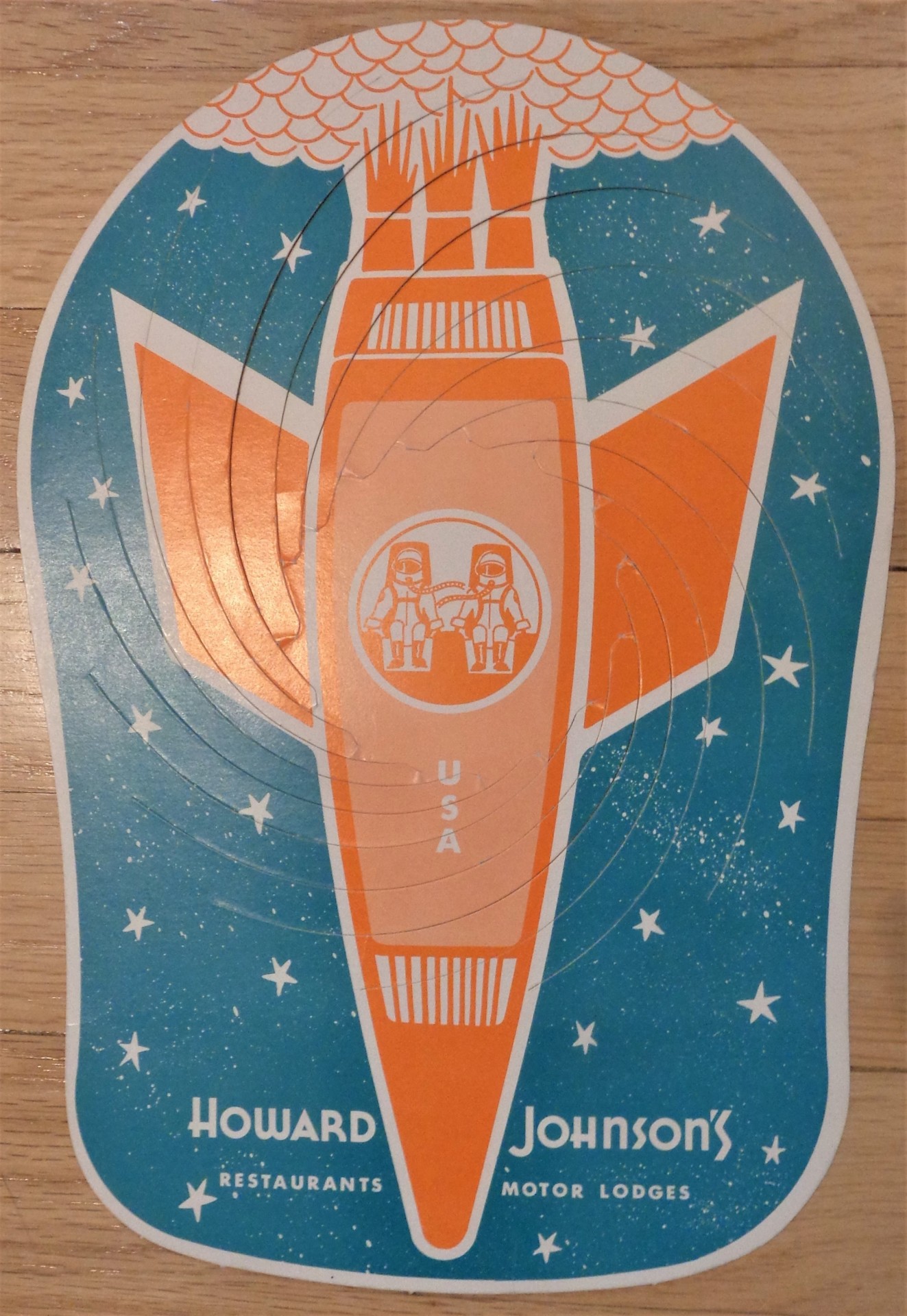
Advertising returned to traditional family values but with often futuristic style. Woman were portrayed as happy in the kitchen with all their new gadgets. Children and teens were targeted for the first time due to the new affluence of their parents. Products targeted toward children included toys, dolls, and a new category, sugared breakfast cereal. Teens were sold phonographs, records, radios, magazines, clothing and soft drinks. Ads were often bright and cheery. One category that took off was automobiles. We were suddenly becoming a two car a family society, which along with the move to the suburbs meant a much bigger demand for cars. Automotive advertising passed cigarettes and packaged goods by the mid-1950s as the most advertised items.
Hojo kids menu, 11 5/8" tall. Everything $0.55 to $1.20. Perforated, can be pushed up from the middle

One interesting aspect of Space Age era advertising was the use of personalities, real and created, and characters. Those created during the period included the Marlboro Man, Frito Bandito, Sonny the Cuckoo Bird (Cocoa Puffs), Punchy (Hawaiian Punch), Toucan Sam (Fruit Loops), Tony the Tiger (Frosted Flakes), Colonel Sanders, Alfred E Neuman (Mad Magazine), Marky Maypo, Ronald McDonald, Pillsbury Doughboy, Piels Brothers, Geoffrey the Giraffe (Toys R Us), and the Trix Rabbit.
Wrigley Juicy Fruit poster, 27 1/2 x 10 1/2".
Vintage advertising is a huge category. There are numerous books, collector’s organizations, and even shows dedicated to it. Items used for advertising besides the products themselves is very comprehensive. It includes roadside signs, billboards, signs, clocks, ashtrays, figurines, television, radio, posters, magazine and newspaper ads, catalogs, match books, toys, trays and much more. Additionally, the products being sold now came in more colorful, better designed boxes and containers. The Mad Men advertisers of the period were a busy group.
A few suggestions for those interested in vintage advertising. The Antique Advertising Association of America (Quad A) issues monthly newsletters and has an annual convention. Its websiteis
https://www.pastimes.org/
The largest vintage advertising show is the Indy Antique Advertising Show offered twice a year in Lebanon, Indiana, and its website is
https://www.indyadshow.com/.
Finding vintage advertising is not hard. It can be found in most antique stores, antique shows, and many auctions. The largest selection of vintage advertising is on eBay. If you are interested in better vintage advertising items the following auction houses specialize in it. All allow online bidding.
Showtime Auctions
http://showtimeauctions.com/
Morphy Auctions
https://www.morphyauctions.com/
Chupp Auctions & Real Estate LLC
https://www.auctionzip.com/IN-Auctioneers/40698.html
Wm Morford
http://morfauction.com/
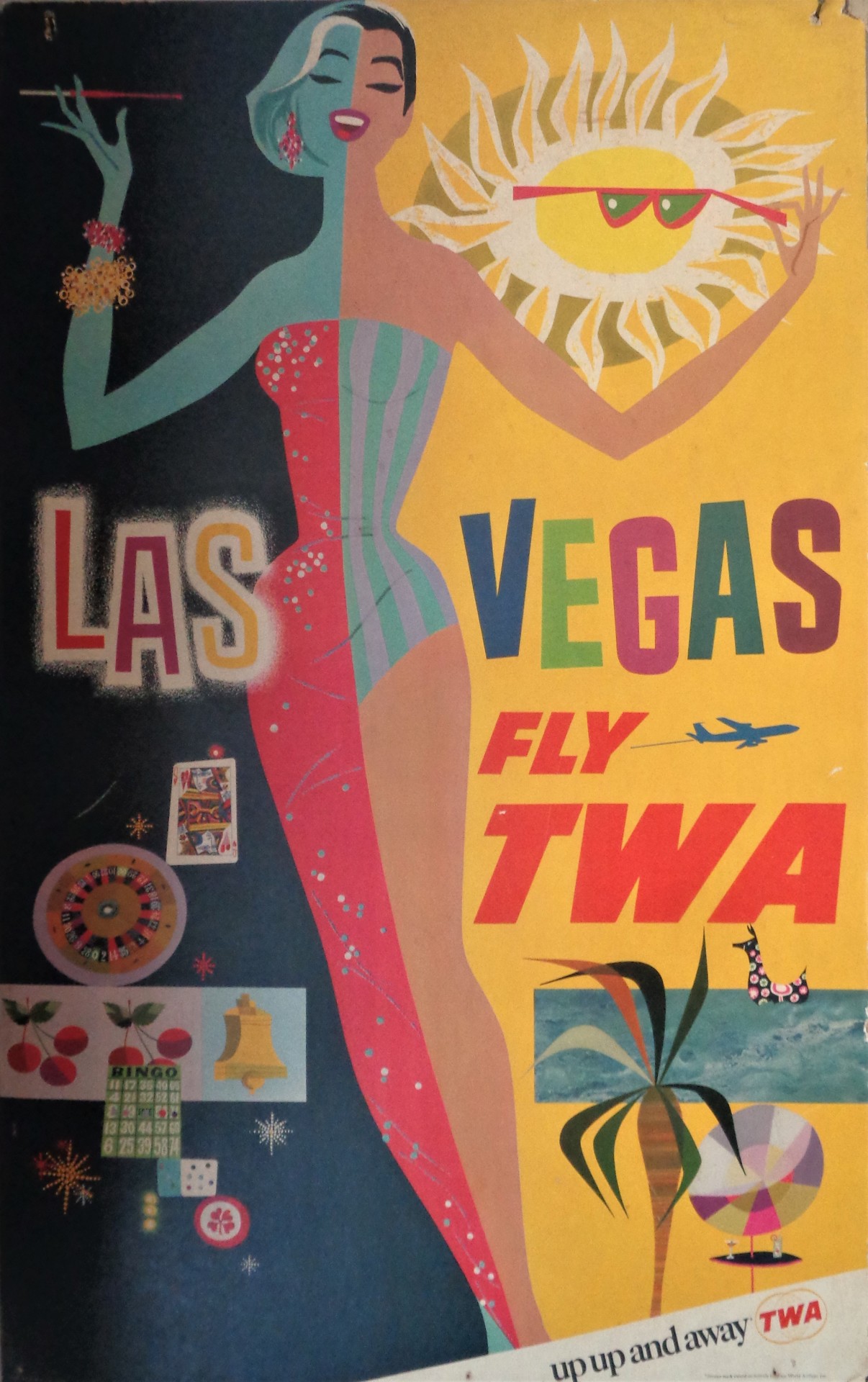
TWA Cardboard poster 40 x 25". Marriage of two space age themes, jet travel and Las Vegas glitz.
Advertising today has changed dramatically since the Space Age, with much of the change occurring in the last ten years. The rise of Google and Facebook has moved a lot of advertising online. This advertising is usually interactive allowing links to larger sites where immediate ordering can be done. Magazines and newspapers have lost the majority of their advertising. Posters and signs are used much less, though billboards remain popular. TV and radio are stagnant. Match books have been mostly replaced by lighters, for those who still smoke.
Smoking advertising, previously a huge source of advertising was phased out. The Surgeon General first warned smoking leads to cancer and Bronchitis in 1964. A warning label was required on all cigarette packs in 1966. Advertising on TV, radio was banned in 1971. After that most advertising was in newspapers, magazines and billboards. Billboards and cartoon characters were banned in 46 states in 1997.
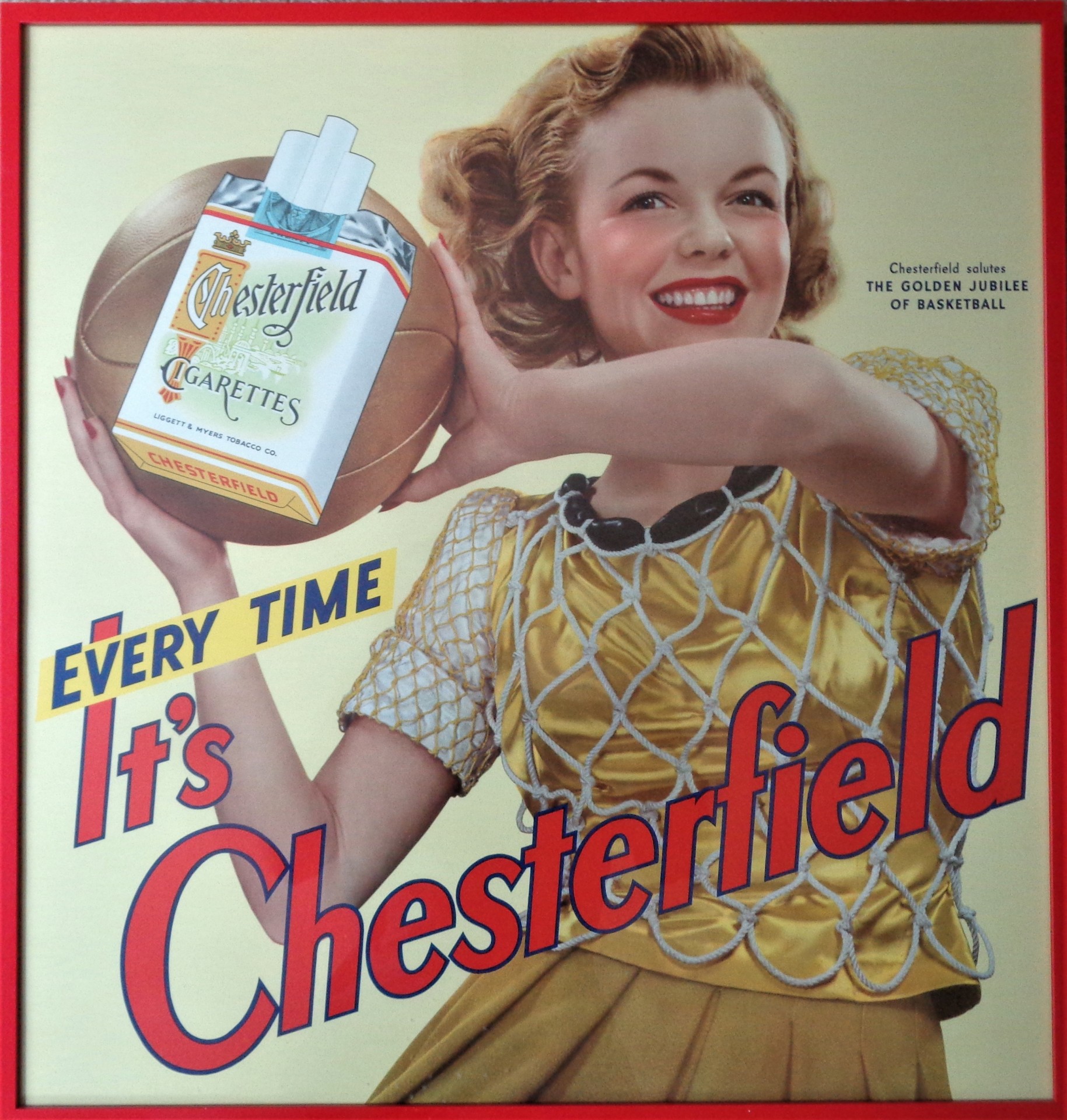
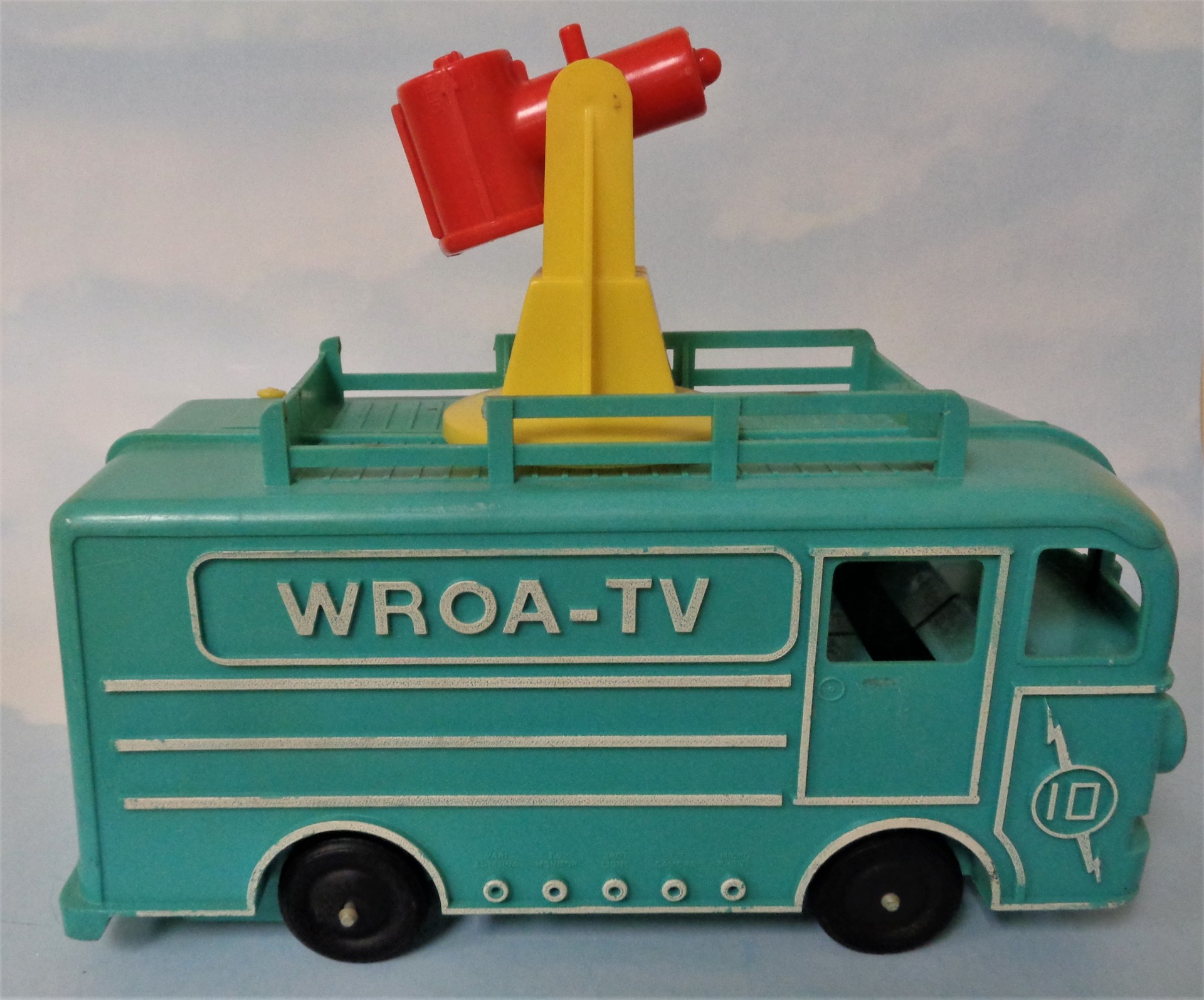
Chesterfield poster 22 x 21". Chesterfield is still made by Phillip Morris and named after a county in Virginia.

Marhoefer paper chef's hat. He may be happy, but I bet he wishes he was an Oscar Meyer Weiner. Marhoefer was a meat company based in Muncie, IN and in business from 1945-1978.
WROA toy plastic truck, 10 1/4" long. Made by toymaker Renwal in 1956 and 1957. I believe WROA was fictional, though there is a radio station in Mississippi.
Beer
The Space Age was a golden age of beer advertising. The vast majority of what is collected today comes from the 1950s through the mid-1970s. This period is dominated by signs, which unlike most other advertising signs from the period, are mostly made of plastic. Also prevalent during this period are neon signs, figurines, coasters, tap handles, ashtrays, mirrors, and cans.


Blatz Beer "Safe at home". Made of pot metal and measures 18 1/2" to the top of the pennant. One of the best examples of beer back bar advertising.
Schlitz metal beer tray. The pre-prohibition period was a great period for beer trays, but good ones were still made in the Space Age. 13 1/4" in diameter.



Strohs plastic sign. Looks like a roadside sign. Measures 15 1/2" high. Strohs a Detroit beer is still made.
This plastic Hamm's bear is a sign, a calendar and a bank. It is 4 plastic pieces plus paper month inserts. Hamm's was a St. Paul, MN brewer. Now owned by Miller. 16" tall.
Sterling Beer mug bank with blonde woman handle. Made of plaster. Sterling was based on Evansville, IN and closed in 1998. 9" tall.


Miller High Life light up clock. Based in Milwaukee. Now owned by the MillerCoors division of the SABMiller–Molson Coors joint venture. Like the beer, that's a mouthful! 20" wide.
Schaefer metal and plastic light up clock. Do you remember the now politically incorrect slogan? "Shaefer is the one beer to have when your having more than one". Originally based in NYC, now owned by Pabst. 12 1/4" wide


Falls City Beer paper poster, 24 1/2" wide. Based in Louisville. Closed in 2007, but revived in 2010, probably thanks to the micro brew explosion and nostalgia.
Schlitz plastic clock, 11" tall.


Hamm's plastic panels sign. 59 1/2" wide.
Outdoor Signs
Outdoor advertising included huge roadside signs, billboards, signs painted on buildings, and this category, outdoor signs. These were often found outside and sometimes inside restaurants, bars, drug stores, country stores and other stores. Most were made of steel, though collectors call them tin as many of the early signs were made of tin. A more expensive process was coating some of them with porcelain. Those signs are generally worth more today due to their shiny look and greater heft. Some outdoor signs such as Flange signs were two sided. After the 1950s, plastic and vinyl signs started to replace the tin ones. Therefore, the Space Age was the last hurrah as far as collectors are concerned of outdoor signs.






Pepsi tn sign, 47" tall. Pepsi had to make its ads count as it was fighting Coke.
Dr. Pepper tin sign, 54" tall. Not just "distinctively different", distinctive sign.
Norka tin soda signs. Norka was based in Akron (Akron spelled backwards) and was in business from 1924 - 1962. Each 24" wide.



Frostie Root Beer plastic clock, 1960s, 18" in diameter. Frostie was based in Detroit, and is still in existence.
Instant Credit tin sign, 25" tall. Store credit was not a new concept, but was now done in a more organized way.
Kayo metal sign, 16" tall. Kayo Oil Company started in 1959, and is now a subsidiary of Phillips 66.

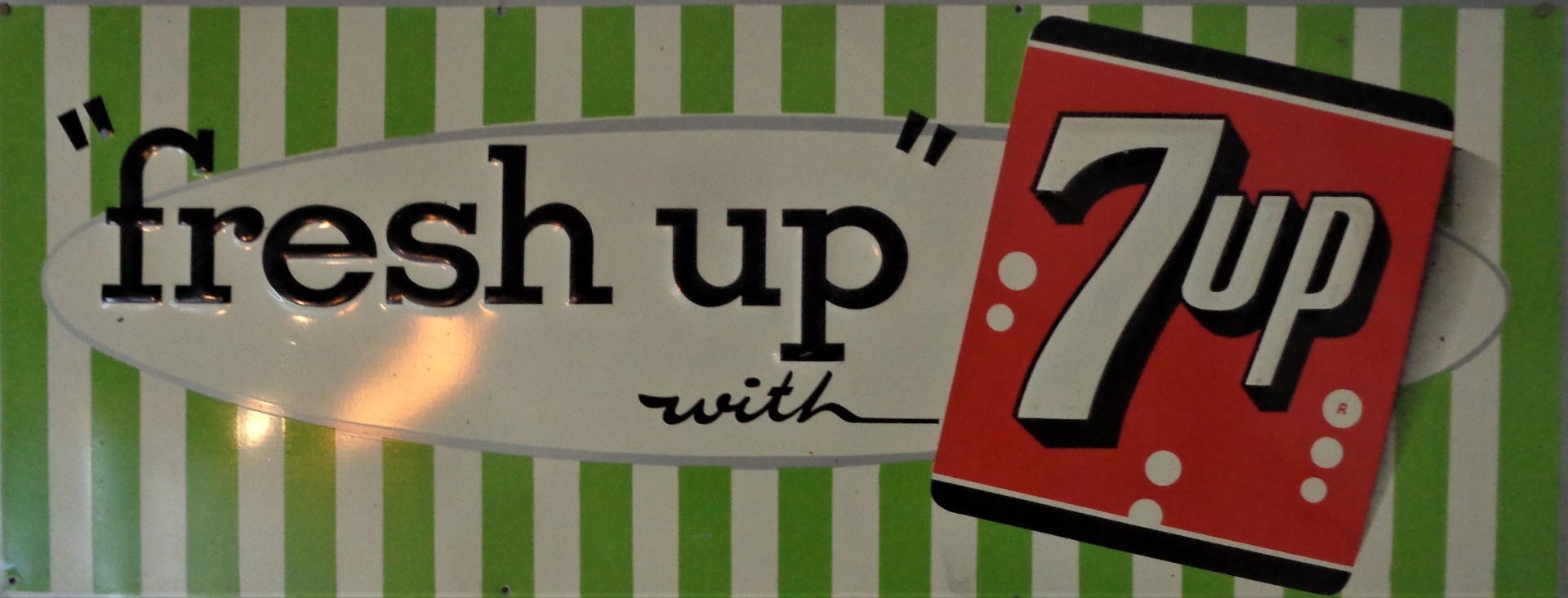
Carnation - Albers Calf Manna Suckle metal sign, 27 5/8" wide. Agricultural signs have become very popular. Carnation no longer makes this product.
7up tin sign, 30" wide. The "fresh up" campaign dates to the 1960s and included a charator, Fresh Up Freddie, who was a bird. A commercial from YouTube is below.


7up Fresh Up Feddie commercial
No-Nox porcelain sign, 17 5/8" tall. Originally part of a Gulf oil pump.
Champale tin sign, 17 1/4" wide. A cross between beer and wine. Originally from Trenton, NJ. Now owned by G. Heileman.


Grapette Soda tin sign, 47" wide. Advertised get this..."imitation grape flavor". Grapette was from Camden, AK. Flourished throughout the south in the 1940s-60s, then died in the 1970s. Recently revived with the original formula.
Royal Crown tin thermometer 13 1/2" tall. Quiky tin thermometer 16" tall. Quiky is no longer, RC going strong.


Dr. Pepper tin sign, 27" wide. Simple yet attention grabbing.

V&S Hardware Stores porcelain sign, 36" in diameter. The letters jump off the page. Not sure where they were, but these signs are not uncommon.
Waverly Soda tin sign, 23 3/8" wide. Waverly was based in Gary, IN and is long gone.


Sunrise Beverages tin sign, 27 3/4" wide. Originally from North Tazewell, VA. Sold in 1956 and moved to Marshall MN. Closed in the 1970s.
Triple AAA Root Beer tin sign, 27 3/4" wide. Based in Oklahoma City. Forced to drop an ingredient "sassafras oil" that was considered a carcinogin. Closed in the 1970s.


Quaker State Motor Oil tin sign, 24" in diameter. This simple sign is enhanced by a bulge of a couple inches in the center.
Nichol Kola tin sign, 57" wide. Bottled in Mount Airy, NC (Mayberry). The company is still around but just does juices now. The top was left blank for the store owner to put his store name.
Much More!
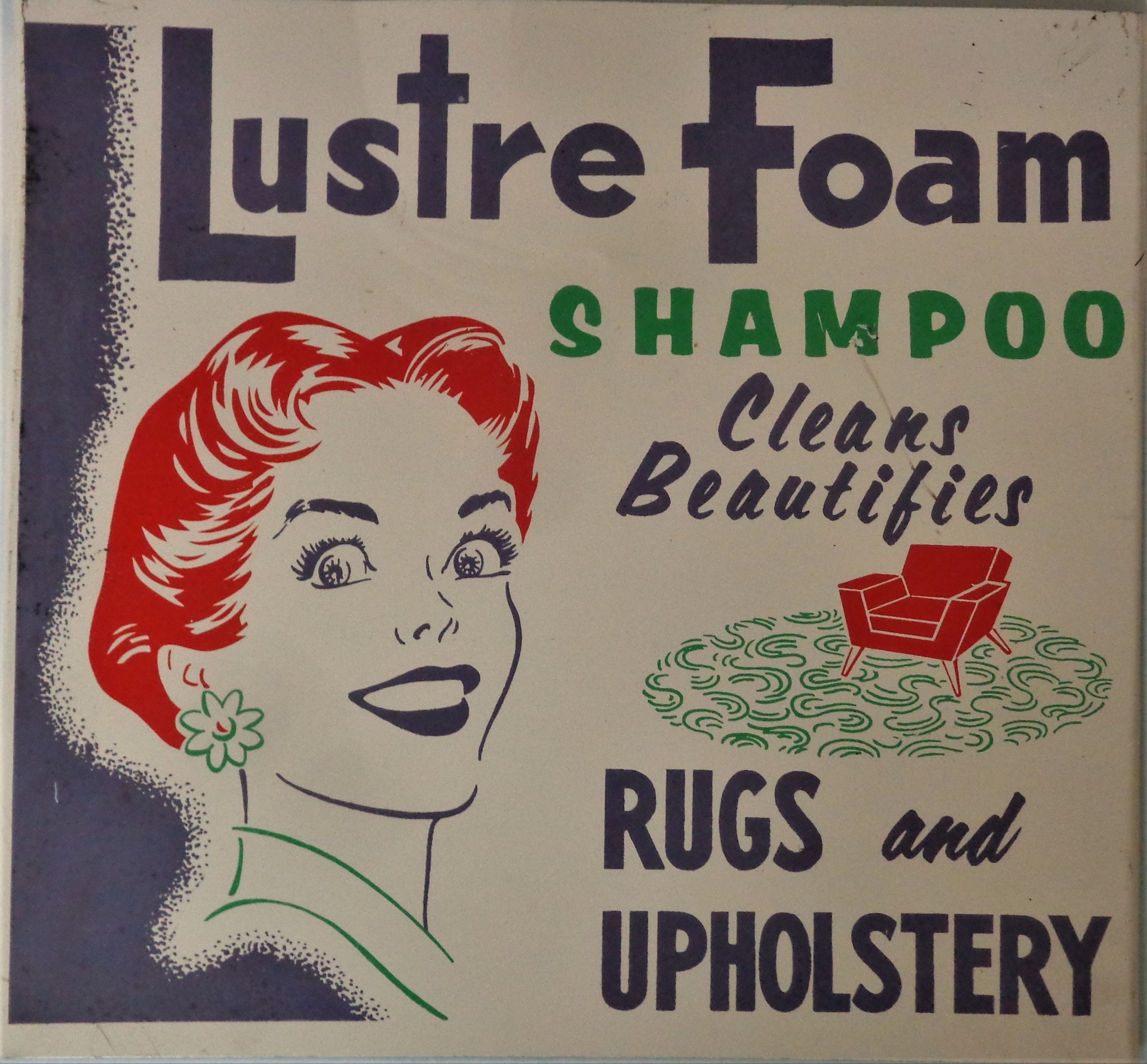

Lustre Foam porcelain display rack top, 9 3/4 x 9". Was the housewife of this era really this glowing?. No longer made.
Beatles metal tray, 13 x 13". Not a lot of Space Age design in England as things weren't as optimistic as here, but they sure loved their Beatles.


Cheerwine paper poster, 16 1/2 x 10 1/2". Cheerwine just celebrated its 100th birthday. This artificially flavored cherry drink is the unofficial soft drink of the State of North Carolina. They even use it in recipes there.
Elvis concert paper poster, 16 1/4 x 10 1/2". Rock concert posters are a whole collecting category by themselves and some early ones are very Space Age.



3D plastic trade sign, 18 1/2" tall.
Project-A-Scope cardboard box, 12 x 8 1/2 x 4 3/4". This is a prime example of the power of advertising. The product inside is a plain black piece of plastic. But look how much fun!
Kalamazoo S&LA glass ashtray, 6 x 6". Even more Space Age than the building itself. Operated from 1886 - 1981.


Eight glass ashtrays measuring 3 1/2 to 4 1/4" wide. The term ashtray came into being in 1926. The golden age of ashtrays started after the end of World War II and ended in 1980s and 1990s when smoking started being banned in public places. The Space Age was the heydey for advertising ashtrays. For this reason, they go well with many midcentury collections. Many ashtrays contained advertising. Hotel, motel and restaurant ashtrays are very common. Ashtrays are made of almost every material that doesn’t burn or melt under heat including glass, brass, pot metal, tin, porcelain, pottery and silver. Ashtrays are usually very affordable and generally cost less than $10. While some ashtrays are on stands, most that have advertising are table top and usually have notches at the rim to hold cigarettes or cigars.
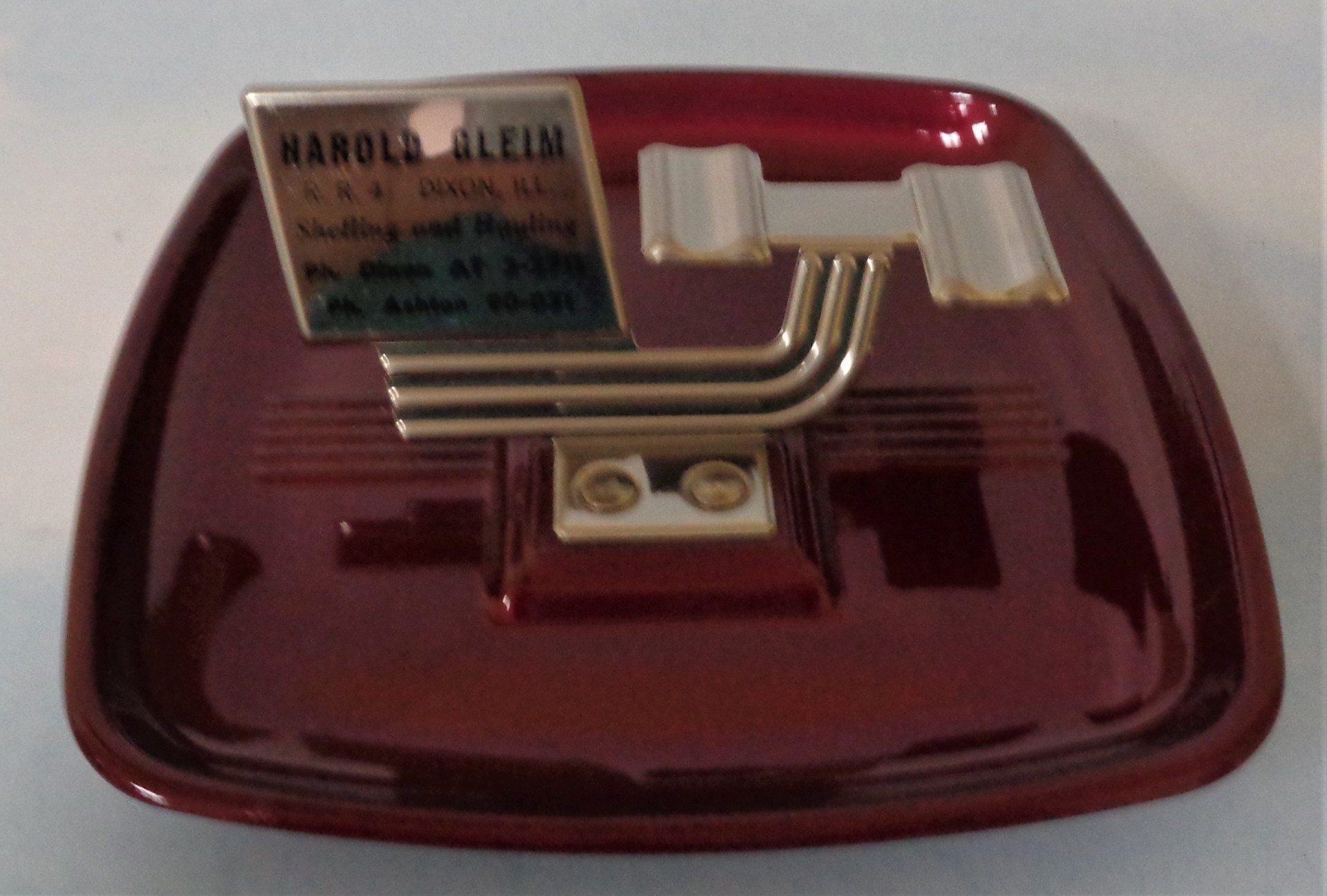
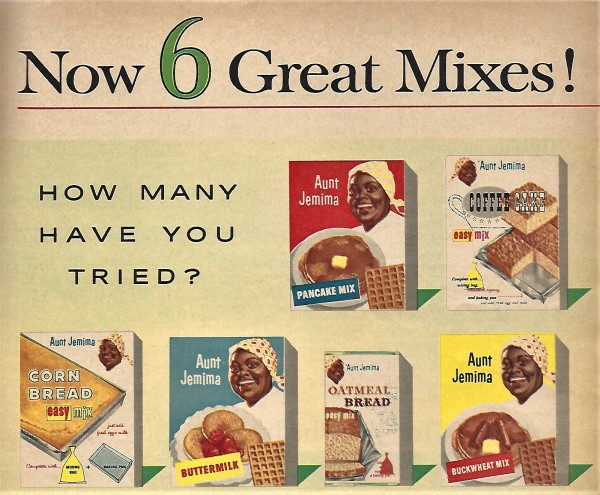
A more elaborate Space Age aluminum ashtray, certainly influenced by the large roadside signs. Harold Gleim was in Dixon, IL and did "Shelling & Hauling" (agricultural). This is likely a stock form used by many. Measures 5 1/2 x 5 1/2"

Peacock Fancy Salmon & Tuna from a postcard.
Ad from September, 1960 Family Circle. Aunt Jemima, like Betty Crocker, changed her appearance over the years based on changes in our culture. Quaker Oats started using her in 1889 and still uses her today.



Menus evolved significantly as the Space Age got going. Color printing became more affordable. Experts were hired to write the many menus, often using puffery or exotic terms to entice diners toward the more expensive items. People like looking at them today to see the low prices were, for local history and seeing foods people no longer eat. The Western Hills Hotel was in Fort Worth, TX. Dominos Italian Village was in Lincoln, NE. The Brahma was in Ocala, FL. All now closed.



Stokely VanCamp 8 1/2" porcelain figurine known as "Easy".
Two page ad for U.S. Steel outdoors products from June 1955 Better Homes. Stereotypical 1950s ad showing family activities with the latest gadgets.



Two page ad for Bryant Heating & Cooling from the June 1955 Better Homes magazine. Too much cheer?
KFC bleacher cushion. Yes, you too could sit on the Colonel at your kids basketball game.
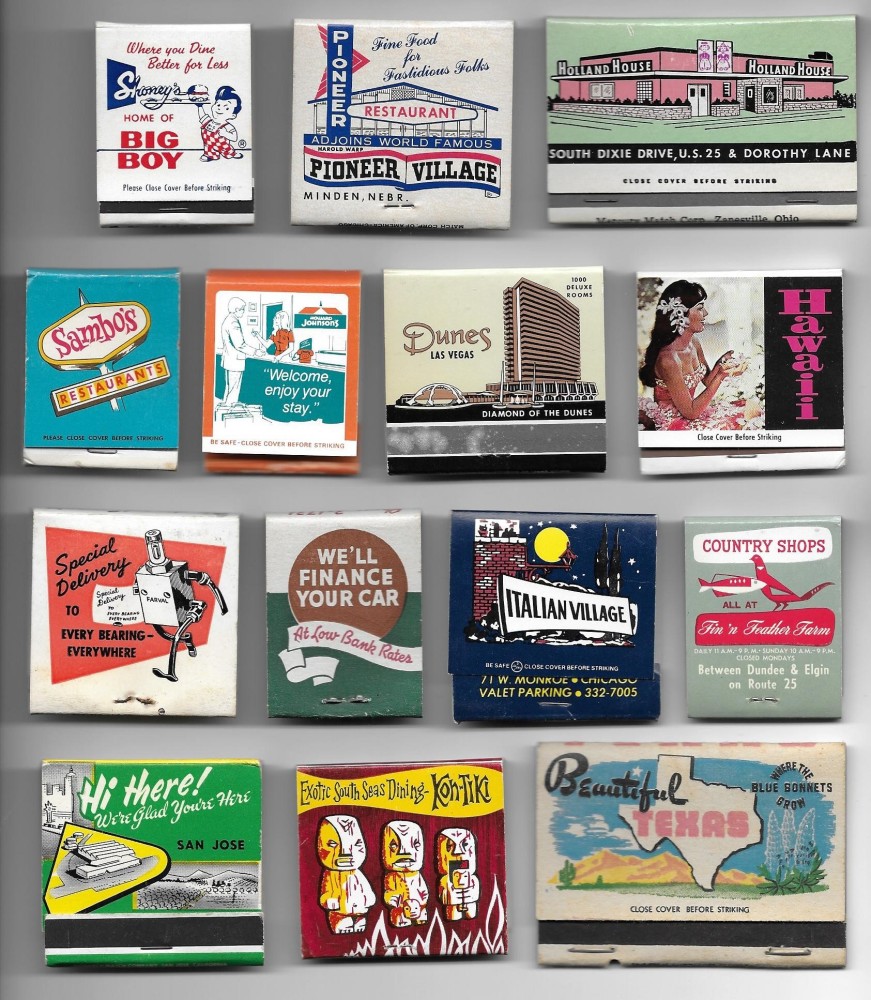
Collectors of matchbooks are known as phillumenists, or "lovers of light". The Rathkamp Matchcover Society has over 600 members and issues a bulletin six times a year.
http://www.matchcover.org/ Matchbooks were invented in 1892 and perfected by1912. The heyday was the 1940s and 1950s after which lighters became a lot more inexpensive and the amount of smokers declined. Matchbooks are still being produced today. Collectors usually remove the matches by carefully removing the staple holding them on as a safety precaution. In some cases where advertising is printed right on the matches they are kept.


RCA Electron Tubes store clock. RCA was one of the first radio manufacturers in 1919, and was still going strong in the Space Age. However, their radios of the period tended to be less futuristic than their peers.

Schlitz hanging lamps. What was found in a bar is today often found in the Mancave.

Chef Boyardee back-lighted sign.
Pepsi store rack sign.